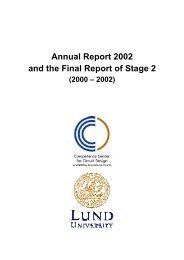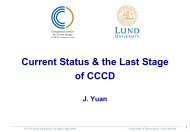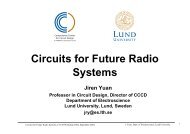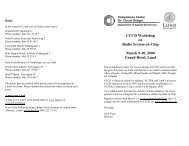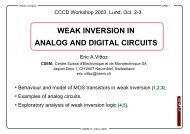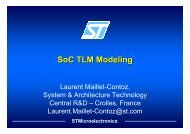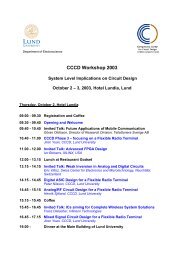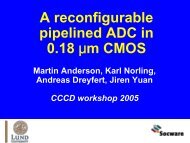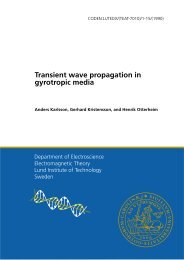Design of Antennas for Handheld DVB-H ... - Lunds tekniska högskola
Design of Antennas for Handheld DVB-H ... - Lunds tekniska högskola
Design of Antennas for Handheld DVB-H ... - Lunds tekniska högskola
You also want an ePaper? Increase the reach of your titles
YUMPU automatically turns print PDFs into web optimized ePapers that Google loves.
unloaded quality factor (Q0) and the external quality factor (Qe). The unloaded<br />
quality factor describes the internal losses, which can be further divided into<br />
radiation, conductor and dielectric losses. The unloaded and radiation (Qrad)<br />
quality factors are in an ideal case equal but in practise there are losses in<br />
dielectrics and conductors, which are included in the dielectric (Qd) and conductor<br />
(Qc) quality factors. The relation between all different quality factors is shown in<br />
equation (2.12) [26].<br />
1<br />
Q<br />
2.3.5 Bandwidth<br />
l<br />
1 1 1 1 1 1<br />
= + = + + +<br />
(2.12)<br />
Q Q Q Q Q Q<br />
0<br />
e<br />
rad<br />
c<br />
d<br />
e<br />
The useful bandwidth is limited by a number <strong>of</strong> factors, <strong>for</strong> example impedance,<br />
gain, polarization or beamwidth. The impedance matching is the main factor<br />
limiting the bandwidth <strong>of</strong> a resonator. The input impedance <strong>of</strong> a small antenna <strong>for</strong><br />
handheld devices varies quickly with frequency, which limits the frequency range<br />
over that the antenna can be matched to its feed line.<br />
The unloaded quality factor is very important because it determines the bandwidth<br />
<strong>of</strong> the antenna. The relatively Bandwidth and the unloaded has the connection<br />
shown in equation (2.13).<br />
B r<br />
=<br />
1<br />
Q<br />
0<br />
( TS −1)(<br />
S − T )<br />
S<br />
23<br />
(2.13)<br />
Where VSWR = S over the impedance bandwidth and T = Y0/G, where G is the<br />
conductance seen at the input <strong>of</strong> a resonator at the resonance frequency and Y0 is<br />
the characteristic admittance <strong>of</strong> the transmission line [26].<br />
2.3.5.1 Impedance matching<br />
A basic task in radio engineering is to match the antenna load to the characteristic<br />
impedance <strong>of</strong> the feed line to prevent voltage reflection (see figure 2.11).<br />
A matching circuit can be realized by lumped elements (capacitor and inductor),<br />
distributed elements (stub or quarter-wavelength trans<strong>for</strong>mer) or by resistive<br />
matching. It is always possible to make a matching circuit as long as the Ra(f) <strong>of</strong><br />
the input impedance is not zero. To design a matching circuit, <strong>for</strong>mulas or Smith<br />
chart can be used. Resistive matching is not recommended because <strong>of</strong> the losses it<br />
results in.<br />
Matching network by lumped elements is close to ideal as long as the physical<br />
lengths <strong>of</strong> the components are clearly smaller than the free-space length and the



